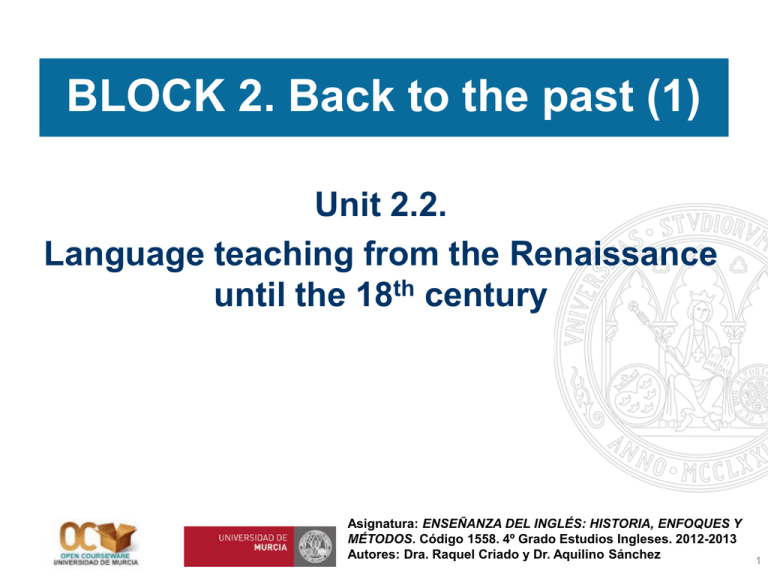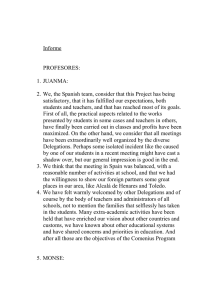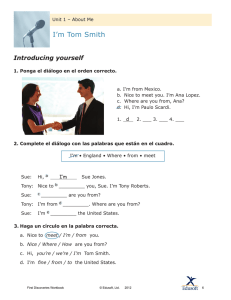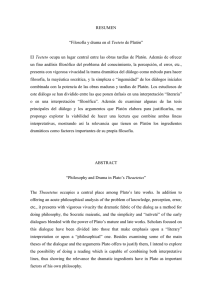Unit 2.2
Anuncio

BLOCK 2. Back to the past (1) Unit 2.2. Language teaching from the Renaissance until the 18th century Asignatura: ENSEÑANZA DEL INGLÉS: HISTORIA, ENFOQUES Y MÉTODOS. Código 1558. 4º Grado Estudios Ingleses. 2012-2013 Autores: Dra. Raquel Criado y Dr. Aquilino Sánchez 1 Outline 1. Objectives of this unit 2. The conversion of Latin into national languages and its effects on language teaching 3. The conversational tradition: the tradition of the books of dialogues Unit 1.3 4. The formal/grammatical tradition Unit 1.3 5. Several important authors (16th-17th centuries): Ascham, Bathe and Comenius 2 1. Objectives of this unit 1. Know how vernacular languages were taught in Europe when they became national languages, in both academic and non-academic contexts. 2. To be aware of the influence of the Latin teaching model in the vernacular languages within the academic sphere. 3. Know the work and legacy of Comenius, the great educator of the seventeenth century, and his predecessor (Bathe) and other authors. 3 2. The conversion of Latin into national languages and its effects on language teaching Do you remember what happened between the 10th and 15th centuries in Europe? • From the 16th century onwards, national languages (French, Italian, Spanish, Portuguese…) gradually displaced Latin as a language of spoken and written communication. • Thus Latin reached the status of a “dead” language whose classical authors (Virgil, Ovid, Cicero…) were to be rediscovered. • It was perceived that the grammar of the classical authors was very different from that of Latin as a lingua franca or Vulgate Latin (Celce-Murcia, 2001: 3), steadily replaced by national languages. 4 2. The conversion of Latin into national languages and its effects on language teaching Which invention was responsible for this discovery and for the increase of the formal study of Greek and Latin grammars? • Formal contexts: The analysis of classical literary texts resulted in a speculative, rationally and abstraction-based study of Latin grammar and rhetoric. Remember from Unit 2.1… When national languages came into scene from the 10th and 11th and centuries onwards, they irremediably adopted the model of Latin teaching: glossaries, texts and dialogues. • Once grammatical descriptions of vernacular languages became available (fifteenth century for Spanish, sixteenth for French, seventeenth century for English, etc.), linguistic rules were also included in the methodology of schools and academic circles. 5 2. The conversion of Latin into national languages and its effects on language teaching GRAMMATICAL TRADITION with prescriptive grammars (following Titone, 1968, Richards & Rodgers, 2001), accompanied as a complement by books of dialogues and glossaries (Sánchez, 1997) But… Was this the only existing teaching methodology? • Also at stake: the real communicative needs of laypeople (business, travels, social and personal relationships). • This allows for the practical nature of dialogue books, precisely created to satisfy these needs ↓ CONVERSATIONAL TRADITION. The tradition of the books of dialogues Do you think that the pedagogical purpose of the books of dialogues in formal and informal contexts was the same? 6 3. The conversational tradition or the tradition of books of dialogues Several important titles (from Howatt, 2004 and Sánchez, 1997) 1483. William Caxton: Dialogues in French and English 1518. Erasmus: Colloquia Puerilia. 1536. Noël de Berlainmont: Vocabulaire … pour apprendre legièrement á bien lire, écrire et parler François et Flameng, lequel est mis tout la plus part par personnaiges. 1538. Luis Vives: Exercitatio linguae latinae. 1554. Anonym: A very profitable boke to lerne the maner of redyng, writing & speakyng English & Spanish. 1565. Baltasar Sotomayor: Grammatica con reglas muy provechosas y necesarias para aprender a leer la lengua francesa y escriuir la lengua francesa conferida con la castellana. 1576. Claudius Holyband: The French Littleton 1580. Jacques Bellot: The English Schoolmaster 1586. Jacques Bellot: Familiar Dialogues 1591. Willam Stepney: The Spanish Schole-Master 1599. John Minsheu: Pleasant and delightful dialogues in Spanish and English. Michel de Montaigne (1580). Learning Latin in the natural way. Sub-block 3.2 (The Natural Approach from the 19th century) 1627. Joseph Webbe: Pueriles confabulatiunculae (Children’s Talk) 7 3. The conversational tradition or the tradition of books of dialogues 1554. Anonym: A very profitable boke to lerne the maner of redyng, writing & speakyng English & Spanish. Catalina: Este dia os desseo muy bueno, parienta comadre y a vuestras compañeras. Margarita. Y yo tambien a vos parienta comadre. Catalina . A que vos tan de mañana por aca? Salis al ayre frio? Quanto ha que venistes? Margarita. Ahora antes de una hora casi que. Catalina. Aueys vendido hoy mucho? Margarita. Que uviera vendido yo tan de mañana? Aun no he recibido las primicias de la estrena. Etc. (In Sánchez, 1997: 52) 8 3. The conversational tradition or the tradition of books of dialogues 1586. Jacques Bellot: Familiar Dialogues The master: What news? The neighbour: There is no other news but of the sickness and the dearth, which be nowadays almost throughout all France… The master: Is the number of them great, that are come over not this country? The neighbour: Very great, and there be many of them which do live very hard, so great is their poverty. (Howatt, 2004: 22) 9 3. The conversational approach or the tradition of books of dialogues 1591. Willam Stepney: The Spanish Schole-Master. Containig seven Dialogues, according to eueryday in the weeke, and what is necessarie euerie day to be done, wherein is also most plainly shewed in the true and perfect pronunciation of the Spanish tongue, toward the furtherance of all those which are desirous to learne the said tongue within our Realme of England. Wherein, besides seven Dialogues, are annexed most fine Prouerbs and sentences as also the Lord prayer, the Articles of our beliefe, the ten Commandements and a Vocabularie, with divers other things necessarie to be knowne in the said tongue (Newly collected and set forth by W. Stepney, professor of the said tongue in the famous Citie of London. Imprinted by R. Field for Iohn Harison), London. El diálogo 1º, "enseña a los caminantes como avian de preguntar el camino desde un lugar hasta otro con diversas platicas". El diálogo 2º, "trata de mercaderias y nos enseña a comprar y vender, con otras muy buenas platicas". El diálogo 3º, "es para cobrar deudas, con otras familiares platicas" El diálogo 4º, "es para hablar a la mesa, a las fiestas y a los banquetes. El diálogo 5º, "nos enseña platicas familiares para usar en el meson" El diálogo 6º, "enseña diversas platicas para usar en el levantar" El diálogo 7º, "nos enseña la platica mas conveniente para usar quando vamos a la yglesia." (Sánchez, 1997: 52) 10 4. The formal/grammatical tradition Three main types of grammars: 1) Formal contexts: Theoretical grammars for native and foreign languages. 2) Informal/private contexts: Pedagogical grammars for native and foreign languages • Real communicative needs of laypeople → Functional and learneroriented • Simple (sometimes even colloquial) description of the language system illustrated with various examples of real use • Most frequent grammatical tradition: clear norms, rules and examples of language use 3) Both contexts: Mixed works 11 4. The formal/grammatical tradition Several important titles (from Howatt, 2004, and Sánchez, 1997) 1492. Antonio de Nebrija: Gramática de la Lengua Castellana. Intenteded for L1 purposes, but also paved the way for the grammars of Spanish as a Foreign Language 1530: John Palsgrave: L’esclarcissement de la langue françoyse 1555 . Anonymous from Louvain: Útil y breve institución para aprender los principios y fundamentos de la lengua hespanola. 1559. Anonymous from Louvain: Gramática de la lengua vulgar de España. 1566. Giovanni Miranda: Osservationi della lingua Castigliana. Model of Spanish grammars for foreigners 1597. Caesar Oudin: Grammaire et observations de la langue espagnole. 1640. Ben Jonson. English Grammar. First English grammar written in standard orthography 1644. Claude Lancelot (grammarian from Port-Royal): Nouvelle Méthode pour apprendre facilement et en peu de temps la langue latine, contenant les règles de genres, des déclinaisons, des prétérites, de la syntaxe, de la quantité et des accents Latins. 1688. Guy Miège: The English Grammar (translation from his Nouvelle Méthode pour Apprendre l’Anglois) A landmark in the development of ELT (Howatt, 2004: 58) 12 Remember: both traditions go hand by hand… Do you think that the tradition of books of dialogues is still present nowadays? 13 5. Several important authors (16th-17th centuries): Ascham, Bathe and Comenius • Increase in utility and prestige of vernacular languages increased people learning foreign languages → Not (only) academic purposes but also real-life communicative needs + • Some attempts to change the deadening experience that the school system must have been for children and, at another level, for adults at university (Howatt, 2004): Unit 3.2.1 Montaigne Roger Ascham William Bathe Jan Amos Comenius 14 5. Several important authors (16th-17th centuries): Ascham, Bathe and Comenius Roger Ascham (1515-1568) • 1570: The Schoolmaster • Applied direct and inverse translation (imitatio) in this order for the texts to be studied. Why do you think he set this particular order? Which teaching orientation did he use, then: deductive or inductive? • Forerunner of interlinear translation. 15 5. Several important authors (16th-17th centuries): Ascham, Bathe and Comenius William Bathe (1564-1614) • Unfairly shadowed by Comenius. • 1611: Janua Linguarum…: Gate to Languages (L1 Spanish-L2 Latin) – How to reconcile flexibility in the use of language (objectives pursued by the books of dialogues) with analysis and systematization as happened in the schools? – Regular and irregular methods in language teaching. What do you think that you achieve with each of one of these methods? • Pedagogy: – Selection of sentences grouped according to lexical and syntactic criteria. – Lexicon is contextualized in sentences. – Frequency and usage criteria for selecting vocabulary. – Selection of thematic content: not frequency topics from daily life, but moral and religious criteria 16 5. Several important authors (16th-17th centuries): Ascham, Bathe and Comenius Jan Amos Comenius (1592-1670) Look at the following extract from one of Comenius’ most acclaimed works: Orbis Sensualium Pictus (1658). Can you notice any distinctive feature in this author’s philosophy of teaching? 17 5. Several important authors (16th-17th centuries): Ascham, Bathe and Comenius Jan Amos Comenius (1592-1670) • “The greatest educationist of the seventeenth century” (Titone, 1968: 14). • Main works: – 1631: Janua Linguarum Reserata Aurea (The Golden Gate to Languages Unlocked). – 1657: Didactica Magna (Great Didactics) – 1658: Orbis Sensualium Pictus (The World in Pictures). Similar methodology to that proposed by Bathe. Comenius refines the lexical selection and provides Bathe’s methodology with sounder theoretical principles (Sánchez, 1997: 68) 18 5. Several important authors (16th-17th centuries): Ascham, Bathe and Comenius Jan Amos Comenius (1592-1670) Read the following extract, which belongs to Comenius’ Janua Linguarum Reserata Aurea (1662 edition, page 1. From Howatt, 2004: 44). It includes some of this author’s tenets of language teaching. Can you explain them in your own words? God save you, friendly Reader. If you demand, what it is to be a good Scholar? I answer, to know the differences of things, and to be able to mark out each thing by its own proper term. Is there nothing else? Nothing sure: he hath laid the ground of all scholarship, who hath thoroughly learnt the right-naming of things. For words are the notes (marks) of things: words being (then) understood aright, things are understood: and both are better learnt together, than asunder. 19 5. Several important authors (16th-17th centuries): Ascham, Bathe and Comenius Jan Amos Comenius (1592-1670) Pioneer of the Direct Method. Most of his principles are summed up in his greatest work, Didactica Magna: “Every language must be learned by practice rather than by rules, especially by reading, repeating, copying, and by written and oral attempts at imitation”. (Comenius, 1657. In Titone, 1968: 14). Could you summarise this in a single word? • Comenius’ principles (Celce-Murcia, 2001: 4) : 1) Use imitation instead of rules to teach a language 2) Have your students repeat after you 3) Use a limited vocabulary initially 4) Help your students practice reading and speaking 5) Teach language through pictures to make it meaningful So, what approach to learning a language did Comenius make explicit for the first time (Celce-Murcia, 2001: 4): Deductive or inductive? 20 5. Several important authors (16th-17th centuries): Ascham, Bathe and Comenius Jan Amos Comenius (1592-1670) • Teaching based on objects. Association of object-pictures is to foster children’s motivation: Pictures are what most easily impress themselves in a child’s mind, to remain lasting and real. Children need to be given many examples, and things they can see, and not abstract rules of grammar. (Linguarum Methodus Novissima. In Titone, 1968: 14) Words must not be learned separately from things, for the word can neither exist nor be understood without the thing. But to the extent that word and thing are joined, they exist somewhere and fulfil a certain function. (Didactica Magna. In Kelly, 1969: 13-14) 21 5. Several important authors (16th-17th centuries): Ascham, Bathe and Comenius Jan Amos Comenius (1592-1670) Underlying all Comenius’ thoughts we find a return to Nature as the leading principle to define language teaching methodology and procedures. He advocates the observation of what happens in the child’s natural surroundings while s/he acquires his/her native language (Sánchez, 1997: 69). 22


